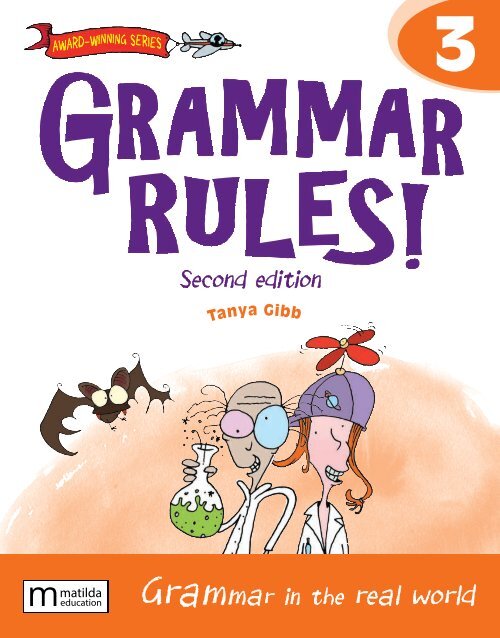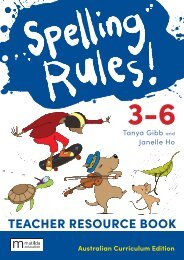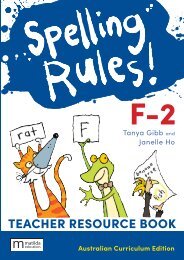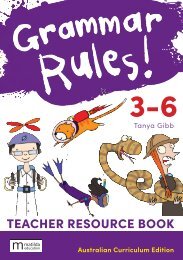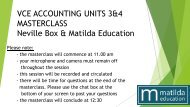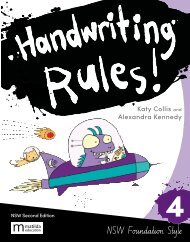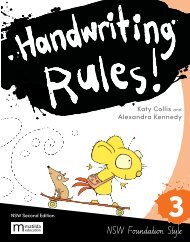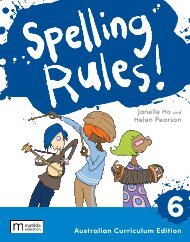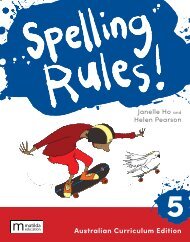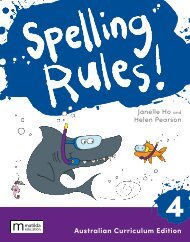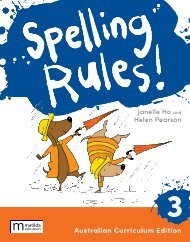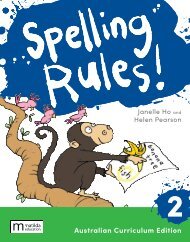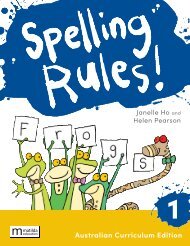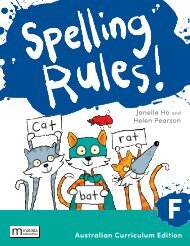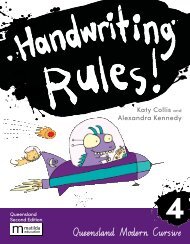You also want an ePaper? Increase the reach of your titles
YUMPU automatically turns print PDFs into web optimized ePapers that Google loves.
AWARD- D-WINNI NNING SERIES<br />
3<br />
Second edition<br />
Tanya Gibb<br />
<strong>Grammar</strong> in the real world
Contents<br />
Note to Teachers and Parents....................................... 2<br />
Scope and Sequence...................................................... 4<br />
Units 1–35..................................................................... 6<br />
<strong>Grammar</strong> <strong>Rules</strong> – a glossary and index....................... 76<br />
Writing Log...................................centre pull-out pages<br />
Thank you to Katy Dalgleish for<br />
her Drolley invention on page 62.<br />
This edition published in 2021 by<br />
Matilda Education Australia, an imprint<br />
of Meanwhile Education Pty Ltd<br />
Level 1/274 Brunswick St<br />
Fitzroy, Victoria Australia 3065<br />
T: 1300 277 235<br />
E: customersupport@matildaed.com.au<br />
www.matildaeducation.com.au<br />
First edition published in 2008 by Macmillan Science and Education Australia Pty Ltd<br />
Copyright © Tanya Gibb/Macmillan Education Australia 2016<br />
All rights reserved.<br />
Except under the conditions described in the Copyright Act 1968 of Australia and subsequent<br />
amendments, no part of this publication may be reproduced, stored in a retrieval system, or transmitted in<br />
any form or by any means, electronic, mechanical, photocopying, recording or otherwise, without the prior<br />
written permission of the copyright owner.<br />
Educational institutions copying any part of this <strong>book</strong> for educational purposes under the Act must be<br />
covered by a Copyright Agency Limited (CAL) licence for educational institutions and must have given a<br />
remuneration notice to CAL. Licence restrictions must be adhered to. Any copies must be photocopies<br />
only, and they must not be hired out or sold. For details of the CAL licence contact: Copyright Agency<br />
Limited, Level 11, 66 Goulburn Street, Sydney, NSW 2000. Telephone: (02) 9394 7600.<br />
Facsimile: (02) 9394 7601. Email: info@copyright.com.au<br />
Publisher: First edition Sharon Dalgleish<br />
Designers: Trish Hayes and Stephen Michael King<br />
Illustrator: Stephen Michael King<br />
Printed in Singapore by Markono Print Media Pte Ltd<br />
1 2 3 4 5 6 7 25 24 23 22 21 20<br />
Supports the English curriculum<br />
Student Book Foundation 1 2 3 4 5 6<br />
Australian Curriculum F 1 2 3 4 5 6<br />
NSW Syllabus Early Stage 1 Stage 1 Stage 2 Stage 3<br />
New Zealand Curriculum 1 2 3 4 5 6 7
Second edition<br />
Tanya Gibb<br />
STUDENT BOOK3<br />
<strong>Grammar</strong> in the real world<br />
Name:<br />
Class:
<strong>Grammar</strong> <strong>Rules</strong>!<br />
<strong>Grammar</strong> <strong>Rules</strong>! comprehensively meets the requirements of the Australian Curriculum English. The scope and<br />
sequence outlined on pages 4–5 integrates Language, Literature and Literacy to develop <strong>student</strong>s’ knowledge,<br />
understanding and skills in listening, reading, viewing, speaking and representing.<br />
<strong>Grammar</strong> <strong>Rules</strong>! also supports the New Zealand English Curriculum strands: Listening, Reading and Viewing; and<br />
Speaking, Writing and Presenting. Students will use processes and strategies to develop knowledge, skills and<br />
understandings, related to purposes and audiences, ideas, language features and structure.<br />
<strong>Grammar</strong> can be defined as the way language is organised to make meaning. Knowledge of the grammatical<br />
features that make language use more effective is vital for all <strong>student</strong>s. They need an understanding of grammar to<br />
be able to make appropriate choices to get their message across in speaking and writing (creating texts); and they<br />
need to know how to analyse the language used by others when they are listening and reading (interpreting texts).<br />
Grammatical knowledge will assist <strong>student</strong>s to become analytical, critical and evaluative language users.<br />
<strong>Grammar</strong> <strong>Rules</strong>! shows <strong>student</strong>s how grammatical structures and features function in texts to achieve meaning, from<br />
the contextual level of the whole text down to sentence level and to the level of words and word parts. The series<br />
explains appropriate grammatical structures for particular types of texts, language functions and social purposes. The<br />
second edition of the <strong>Grammar</strong> <strong>Rules</strong>! program also incorporates elements of self-assessment. A simple reflection<br />
activity allows <strong>student</strong>s to assess their own progress and provides you with a starting point for discussion.<br />
Student Book 3<br />
Units of work<br />
Student Book 3 contains 35 weekly units of work presented in a conceptually sound scope and sequence. The<br />
intention is for <strong>student</strong>s to work through the units in the sequence in which they are presented. See the<br />
Scope and Sequence Chart on pages 4–5 for more information. There are also regular Revision Units that<br />
can be used for consolidation or assessment purposes.<br />
The <strong>sample</strong> texts in Student Book 3 are based around the theme of discoveries and inventions. The subject<br />
matter of the <strong>sample</strong> texts is not tied to any particular content across other curriculum areas. This allows<br />
teachers and <strong>student</strong>s to focus on the way language is structured according to purpose and audience.<br />
Students can then use this knowledge to evaluate, respond to and create texts in other learning areas.<br />
The concepts in the <strong>sample</strong> texts link well with the Cross-Curriculum Priority of Sustainability, as well the<br />
General Capabilities of Critical and Creative Thinking, Personal and Social Capability, Ethical Understanding<br />
and Intercultural Understanding, as described in the Australian Curriculum.<br />
Icons<br />
Note to teachers and parents<br />
Try it<br />
yourself!<br />
Encourages <strong>student</strong>s to create texts of their own to demonstrate their understanding of the<br />
grammatical concepts taught in the unit. These activities focus on written language; however,<br />
many also provide opportunities for using spoken language to engage with others, make<br />
presentations and develop skills in using ICT.<br />
Rule!<br />
Tip!<br />
Highlights useful grammatical rules and concepts. The rule is always<br />
introduced the first time <strong>student</strong>s need it to complete an activity.<br />
Tells <strong>student</strong>s that a special hint is provided for an activity. It might<br />
be a tip about language functions, or a reminder to <strong>look</strong> at a rule<br />
in a previous unit.<br />
Reflection<br />
I can do this.<br />
I am not sure.<br />
I need help.<br />
Allows <strong>student</strong>s<br />
to assess their<br />
progress through<br />
each unit.<br />
Gram m ar Rule s Glossary<br />
A valuable glossary is provided at the end of Student Book 3. Teachers and <strong>student</strong>s can use this as a<br />
straightforward dictionary of grammar terminology, or as a summary of important grammar rules used in<br />
Student Book 3. Page references are also given for the point in the <strong>book</strong> where the rule was first introduced,<br />
so that <strong>student</strong>s can go back to that unit if they need more information or further revision of the rule.<br />
2
© Tanya Gibb/Macmillan Education Australia 2016<br />
<strong>Grammar</strong> <strong>Rules</strong>! Student Book 3 (ISBN 9781420236590) © Tanya Gibb/Macmillan Education Australia<br />
© Tanya Gibb/Macmillan Education Australia 2016<br />
<strong>Grammar</strong> <strong>Rules</strong>! Student Book 3 (ISBN 9781420236590) © Tanya Gibb/Macmillan Education Australia<br />
<strong>Grammar</strong> <strong>Rules</strong>! Student Book 3 (ISBN 978 1 4202 3659 0) © Macmillan Education Australia<br />
Pull-Out Writing Log<br />
At the centre of Student Book 3 is a practical pull-out Writing Log so that <strong>student</strong>s can directly relate<br />
the grammar they learn back to their own writing. Students could store the Writing Log in their writing<br />
folders, and use it to keep track of the grammar, language functions and types of texts they use. The<br />
Writing Log also includes a handy reminder of the writing process, as well as a checklist of types of texts<br />
and text forms for <strong>student</strong>s to try.<br />
Create symbols<br />
Type of text<br />
Date<br />
Title<br />
Audience <strong>Grammar</strong> I used My rating Where to next?<br />
for a rating scale.<br />
and text form<br />
<strong>Grammar</strong> <strong>Rules</strong>!<br />
Then each time<br />
Write the Write the title of your eg recount/ Who were you List the main grammar features you used. Record your What grammar could you try next?<br />
you finish a piece date. piece.<br />
letter writing for or to?<br />
rating.<br />
How could you improve your writing?<br />
of writing, record<br />
Does your teacher have any comments?<br />
it in the log.<br />
's Writing Log<br />
My rating scale<br />
Symbol Meaning<br />
I Think<br />
Help!<br />
What is your topic?<br />
What is the purpose of the writing? 2 Draft<br />
Who is the audience?<br />
A good<br />
Gather your ideas.<br />
start.<br />
What type of text and text form will<br />
Organise your ideas.<br />
you use?<br />
Have a go at writing.<br />
I have the<br />
basics<br />
covered.<br />
3 Revise<br />
4 Proofread<br />
I'm<br />
Check your writing for meaning and<br />
beyond<br />
ideas.<br />
Polish your writing.<br />
the<br />
basics.<br />
Have you chosen the best words Check your grammar.<br />
for your topic?<br />
Check your spelling.<br />
Brilliant!<br />
Does the structure match the<br />
Check your punctuation.<br />
type of text you chose?<br />
Read your writing to a partner.<br />
Read your writing to your teacher.<br />
5 Publish<br />
Do you need<br />
Ask for help to improve your writing.<br />
some ideas for<br />
Publish your writing.<br />
other text forms<br />
Share your writing.<br />
to try? Look at<br />
Reflect on your writing.<br />
the back page!<br />
© Tanya Gibb/Macmillan Education Australia 2016 i ii iii<br />
iv<br />
I've tried these types of texts and text forms . . .<br />
Narrative (imaginative) Exposition (persuasive)<br />
Story<br />
(argues one side of an issue)<br />
Comic<br />
Debate<br />
Other<br />
Speech<br />
TV advertisement<br />
Recount<br />
Poster<br />
(imaginative or informative)<br />
Other<br />
Letter<br />
Information report<br />
Newspaper article<br />
(informative)<br />
Other<br />
Scientific report<br />
Description<br />
Website<br />
(imaginative or informative)<br />
Other<br />
Poem<br />
Explanation (informative)<br />
Wanted poster<br />
Letter<br />
Reference <strong>book</strong><br />
Other<br />
Other<br />
Response (persuasive) Procedure (informative)<br />
Diary<br />
Cook<strong>book</strong><br />
Book review<br />
Instruction manual<br />
Poem<br />
Game rules<br />
Other<br />
Other<br />
Discussion (persuasive)<br />
(presents more than one side<br />
of an issue)<br />
Conversation<br />
TV interview<br />
Dialogue in a story<br />
Other<br />
Unit at a Glance<br />
Unit tag<br />
States the main<br />
grammar focus<br />
Type of text<br />
Highlights the<br />
type of text and<br />
purpose of the<br />
<strong>sample</strong> text, and<br />
any particular<br />
grammar focus<br />
Rule!<br />
Introduces<br />
<strong>student</strong>s to a<br />
new concept<br />
Text <strong>sample</strong><br />
Illustrates the grammar focus<br />
at work, in the real context<br />
of a specific type of text<br />
8Unit<br />
5<br />
Rule!<br />
Saying verbs,<br />
fact and<br />
opinion<br />
This film review<br />
is a persuasive text.<br />
It is a response to a<br />
movie. It includes the<br />
writer’s opinion.<br />
Inventing Potato Chips<br />
I saw a really entertaining The customer said they<br />
movie about the invention were fantastic. So that’s how<br />
of potato chips. A chef in potato chips were invented.<br />
a restaurant in America The movie was very funny.<br />
in about 1850 made I enjoyed it.<br />
French fries. A customer<br />
complained that the fries<br />
weren’t thin enough. The<br />
chef kept making them<br />
thinner and thinner but the<br />
customer kept saying they<br />
still weren’t thin enough.<br />
Finally, the chef fried paperthin<br />
slices and sprinkled<br />
them with plenty of salt.<br />
Saying verbs are verbs that show you something is being said.<br />
asked screamed shouted<br />
I Read Inventing Potato Chips. Underline the saying verb in each sentence below.<br />
A customer complained that the fries weren’t thin enough.<br />
The customer said they were fantastic.<br />
2 Use a saying verb from the box to complete each sentence.<br />
stated cheered told asked announced<br />
3 Write a sentence for each saying verb in the box.<br />
whispered<br />
yelled<br />
cried<br />
The customer<br />
that the fries were too thick.<br />
The customer<br />
the chef to try again.<br />
Try it<br />
Reflection<br />
The customer<br />
the chef to make the fries thinner.<br />
yourself!<br />
Write a review as a response to a movie or television<br />
I can do this.<br />
The customer<br />
the fries were perfect.<br />
show. Use thinking and feeling verbs to tell your opinion. I am not sure.<br />
The chef<br />
when the customer was happy.<br />
I need help.<br />
Saying verbs; thinking and feeling verbs; fact and opinion<br />
14 15<br />
Tip!<br />
4<br />
5<br />
Sequenced activities<br />
Each activity focuses<br />
on a specific aspect of<br />
grammar<br />
Response texts use thinking and feeling verbs to represent someone’s<br />
opinion. Personal opinions are not facts.<br />
Write the sentence from Inventing Potato Chips that uses a thinking and feeling verb to tell you<br />
the writer’s opinion.<br />
Colour the face that shows how the writer felt about the movie.<br />
6 Write fact or opinion after each sentence.<br />
I loved the movie.<br />
Potato chips are healthy.<br />
Potato chips are made from potatoes.<br />
Chefs are clever at inventing new recipes.<br />
I like eating in restaurants.<br />
7 Write a fact about your class.<br />
8 Write an opinion about your class.<br />
There are 26 <strong>student</strong>s in my class. My class is the best in the world.<br />
Footer<br />
Lists the full grammar focus covered in the unit<br />
Tip!<br />
Reminds or gives<br />
a special hint<br />
Try it yourself!<br />
Gives <strong>student</strong>s the<br />
opportunity to apply<br />
grammar in the context of<br />
their own texts using the<br />
<strong>sample</strong> texts as models.<br />
Provides opportunities<br />
for planning, drafting and<br />
editing texts using software<br />
and word processing<br />
programs to publish them<br />
Reflection<br />
Allows <strong>student</strong>s to assess<br />
their progress<br />
<strong>Grammar</strong> <strong>Rules</strong>! Teacher Resource Book 3–6<br />
Full teacher support for Student Book 3 is provided by <strong>Grammar</strong> <strong>Rules</strong>! Teacher Resource Book 3–6.<br />
Here you will find valuable background information about grammar, along with practical resources, such as:<br />
N strategies for teaching grammar N teaching tips for every unit in Student Book 3<br />
N grammar games and activities N answers for every unit in Student Book 3<br />
N assessment strategies<br />
3
Scope and Sequence<br />
Unit<br />
Unit name/<br />
Type of text<br />
Sentences<br />
and<br />
clauses<br />
This scope and sequence chart is based on the requirements of the Australian Curriculum.<br />
Clause to whole text level<br />
Cohesion: theme,<br />
pronouns, lexical<br />
chains, connectives<br />
Mood and<br />
modality,<br />
language and<br />
vocabulary<br />
Nouns and noun<br />
groups<br />
Word and word group level<br />
Verbs and verb<br />
groups<br />
Adverbs and<br />
prepositional<br />
phrases<br />
1<br />
Museum Visit<br />
Recount<br />
proper and common<br />
nouns<br />
doing verbs;<br />
past tense<br />
2<br />
A Tasty Invention<br />
Recount<br />
sentences<br />
proper and common<br />
nouns<br />
thinking and feeling<br />
verbs<br />
3<br />
Dear Nana and Pop<br />
Response/Email<br />
simple<br />
sentences;<br />
clauses<br />
1st and 2nd person<br />
personal pronouns:<br />
I, me, we, us, you<br />
thinking and feeling<br />
verbs<br />
4<br />
The Case of the<br />
Missing Robots<br />
Narrative<br />
personal pronouns:<br />
she, he, him, her,<br />
they, them, it<br />
noun groups with<br />
adjectives<br />
5<br />
Inventing Potato Chips<br />
Response/Film review<br />
fact and<br />
opinion<br />
saying verbs; thinking<br />
and feeling verbs<br />
6<br />
REVISION<br />
7<br />
My Special Place<br />
Narrative/Poem<br />
phrases<br />
noun groups with<br />
adjectives<br />
prepositional<br />
phrases<br />
8<br />
Nintendo<br />
Information report<br />
personal pronouns technical words proper nouns relating verbs<br />
9<br />
Penicillin<br />
Recount<br />
questions and<br />
statements<br />
time words and<br />
phrases<br />
10<br />
Molly’s Discovery<br />
Narrative<br />
conjunctions<br />
(connectives)<br />
singular and plural<br />
nouns<br />
subject/verb<br />
agreement<br />
11<br />
Search for the Lost<br />
Valley<br />
Narrative<br />
exclamations;<br />
onomatopoeia<br />
adverbs to tell<br />
how<br />
12<br />
REVISION<br />
13<br />
Trampolines<br />
Discussion/Conversation<br />
quoted<br />
speech;<br />
speech<br />
marks<br />
evaluative<br />
words;<br />
apostrophes for<br />
contractions<br />
saying verbs<br />
14<br />
The Thing Inside<br />
Narrative<br />
modality;<br />
emotive words<br />
15<br />
Where to Find the<br />
Hidden Treasure<br />
Procedure/Directions<br />
commands doing verbs prepositional<br />
phrases and<br />
adverbs<br />
16<br />
Wiz Bang 3000<br />
Kitchen Hand!<br />
Advertisement<br />
personal pronouns<br />
emotive words;<br />
modality (modal<br />
verbs, modal<br />
adverbs)<br />
17<br />
Discovery: A New<br />
Species<br />
Description<br />
noun groups; articles;<br />
comparing adjectives<br />
18<br />
REVISION<br />
4
Clause to whole text level<br />
Unit<br />
Unit name/<br />
Sentences Cohesion: theme, Mood and<br />
Type of text and pronouns, lexical modality,<br />
clauses chains, connectives language and<br />
vocabulary<br />
Nouns and noun<br />
groups<br />
Word and word group level<br />
Verbs and verb<br />
groups<br />
Adverbs and<br />
prepositional<br />
phrases<br />
19<br />
Voyagers<br />
Description/Poem<br />
simile; idiom<br />
apostrophes for<br />
possession<br />
20<br />
Everyone Should Recycle<br />
Exposition/Speech<br />
connectives<br />
fact and opinion<br />
21<br />
Professor Snodgrass<br />
Fails Again<br />
Narrative/Comic strip<br />
quoted<br />
speech<br />
stereotypes<br />
22<br />
Dinosaur Found at<br />
Local School<br />
Recount/Newspaper<br />
article<br />
reported<br />
speech<br />
emotive words;<br />
sensationalism<br />
concrete and<br />
abstract nouns<br />
23<br />
The Jacket<br />
Narrative<br />
time words<br />
past, present and<br />
future tense<br />
adverbs and<br />
prepositions<br />
24<br />
REVISION<br />
25<br />
The Best New Invention<br />
Discussion<br />
connectives modality noun groups<br />
26<br />
Breakfast Inventions<br />
Description/Poem<br />
lexical chains metaphor descriptive adjectives<br />
27<br />
Wart, Fester and<br />
Carbuncle Remover<br />
Procedure/Recipe<br />
commands<br />
number adjectives<br />
(quantifiers)<br />
doing verbs<br />
adverbs to tell<br />
how<br />
28<br />
How Does the Alarm<br />
Bed Work?<br />
Explanation<br />
connectives<br />
technical<br />
language;<br />
evaluative<br />
language<br />
nouns<br />
doing verbs<br />
29<br />
How to Use the Drolley<br />
(or Dog Trolley)<br />
Procedure/Instructions<br />
evaluative<br />
language<br />
noun groups;<br />
classifying adjectives<br />
30<br />
REVISION<br />
31<br />
My Home<br />
Narrative/Poem<br />
personal pronouns<br />
evaluative<br />
language<br />
collective nouns<br />
32<br />
Trying to Negotiate<br />
Discussion/Conversation<br />
quoted<br />
speech<br />
synonyms<br />
statements;<br />
questions;<br />
commands;<br />
exclamations<br />
33<br />
Dear Diary<br />
Response/Diary<br />
quoted<br />
speech;<br />
speech<br />
marks<br />
lexical chains;<br />
synonyms<br />
evaluative<br />
language<br />
34<br />
The Invention of<br />
Money<br />
Information report<br />
commas in<br />
noun lists<br />
personal pronouns homophones noun groups;<br />
commas in noun lists<br />
35<br />
REVISION<br />
5
Unit<br />
I<br />
Nouns,<br />
doing verbs<br />
This text<br />
is informative. It<br />
recounts a series of<br />
events.<br />
Museum Visit<br />
Last weekend my mum took me to the National Museum of<br />
Australia in Canberra. We left home at 7 am and drove for<br />
two hours. We arrived before the museum even opened.<br />
I was excited to be able to go <strong>inside</strong> when it opened at<br />
10 am. I saw lots of interesting exhibits and displays. There<br />
was also a special area for kids. We ate sandwiches and<br />
milkshakes for lunch in the Museum Café. After lunch we<br />
went for a walk beside Lake Burley Griffin. The museum<br />
closed at five o’clock so we finally had to go home.<br />
Rule!<br />
Nouns are words for people, places, animals or things.<br />
Proper nouns are the names of particular people, places, animals or things.<br />
They begin with a capital letter.<br />
Saturday Stephen Tasmanian devil December Hobart<br />
Common nouns are everyday naming words.<br />
day scientist dinosaur month car<br />
I<br />
Read Museum Visit. Write the common nouns used.<br />
people<br />
places<br />
food<br />
2<br />
Write the proper nouns used in Museum Visit.<br />
6<br />
<strong>Grammar</strong> <strong>Rules</strong>! Student Book 3 (ISBN 9781420236590) © Tanya Gibb/Macmillan Education Australia
3 Underline six nouns for people, places,<br />
animals or things.<br />
4 Circle the noun in each row.<br />
We parked our car under a tree.<br />
dog skipped ate played<br />
We watched a film about bees.<br />
visited drove saw cat<br />
We sat at a table to eat.<br />
stopped bird climbed watched<br />
Many people visit the museum.<br />
jumped tickled swan said<br />
talked sang wiggled wombat<br />
Rule!<br />
Doing verbs tell the actions that are happening.<br />
Sometimes the way a verb is written lets you know that<br />
the action happened in the past. This is called past tense.<br />
jumped ran made wrote<br />
5 Underline a doing verb in each sentence.<br />
We ate lunch.<br />
Mum drove the car.<br />
Dad worked on his invention.<br />
I built a robot.<br />
We played catch.<br />
6<br />
drive<br />
take<br />
see<br />
eat<br />
close<br />
Write the past tense form for each doing verb.<br />
Hint! You’ll find the answers in Museum Visit.<br />
7<br />
Choose a doing verb from the box to complete each sentence.<br />
visited worked slept swam<br />
We<br />
Ducks<br />
I<br />
Dad<br />
the museum.<br />
on the lake.<br />
well after my big day.<br />
all day.<br />
Try it<br />
yourself!<br />
Write a recount about something that happened to you<br />
last weekend. Use nouns for people, places and things.<br />
Remember to use the past tense forms of the verbs.<br />
Proper and common nouns; doing verbs; past tense<br />
<strong>Grammar</strong> <strong>Rules</strong>! Student Book 3 (ISBN 9781420236590) © Tanya Gibb/Macmillan Education Australia<br />
Reflection<br />
I can do this.<br />
I am not sure.<br />
I need help.<br />
7
Unit<br />
2<br />
Nouns,<br />
thinking and<br />
feeling verbs<br />
This text is<br />
informative. It<br />
recounts events in a<br />
time sequence. It uses<br />
thinking and feeling<br />
verbs.<br />
A Tasty Invention<br />
John Montagu invented the first<br />
sandwich in 1762. Montagu loved<br />
playing card games. He hated<br />
to stop playing to eat or even to<br />
sleep. One day he was playing a<br />
card game that had already lasted<br />
24 hours. He was really hungry<br />
so he asked for some slices of<br />
bread and some meat. Other<br />
card players watched him put the<br />
meat in between two slices of bread. He ate with one hand<br />
while he continued to play cards with the other. His friends<br />
named the bread and meat invention a sandwich because<br />
Montagu was the Earl of Sandwich.<br />
I<br />
2<br />
Read A Tasty Invention. Circle the common nouns.<br />
Underline the proper nouns used in A Tasty Invention.<br />
Tip!<br />
Remember<br />
the rule on<br />
page 6.<br />
Tip!<br />
Sentences start with a capital letter and end in<br />
a full stop, question mark or exclamation mark.<br />
3 Rewrite each sentence with correct punctuation.<br />
Hint! Names for months and days of the week are proper nouns.<br />
john montagu lived in england<br />
the earl of sandwich was very rich<br />
uncle jack lives on woodland road<br />
today is friday<br />
my friends are jin and waiyin<br />
8<br />
<strong>Grammar</strong> <strong>Rules</strong>! Student Book 3 (ISBN 9781420236590) © Tanya Gibb/Macmillan Education Australia
4<br />
Write common nouns for things you can<br />
eat<br />
play with<br />
draw with<br />
cuddle<br />
Rule!<br />
Thinking and feeling verbs represent mental activities such as loving,<br />
hoping and believing. You can’t see these activities taking place.<br />
think wish like consider<br />
5<br />
Write the thinking and feeling verbs used in A Tasty Invention.<br />
6<br />
Circle the thinking and feeling verbs.<br />
Montagu liked meat.<br />
He hoped the sandwich would taste good.<br />
Montagu loved sandwiches.<br />
I enjoyed my sandwiches.<br />
7<br />
Use each thinking and feeling verb in a sentence.<br />
wonder think believe wish<br />
Try it<br />
yourself!<br />
Ask a family member to recount something you did when<br />
you were a baby. Ask how they felt as they watched<br />
you. Write the recount using thinking and feeling verbs.<br />
Remember that people’s names are proper nouns.<br />
Reflection<br />
I can do this.<br />
I am not sure.<br />
I need help.<br />
Sentences; proper and common nouns; thinking and feeling verbs<br />
<strong>Grammar</strong> <strong>Rules</strong>! Student Book 3 (ISBN 9781420236590) © Tanya Gibb/Macmillan Education Australia<br />
9
Unit<br />
3<br />
Clauses,<br />
personal<br />
pronouns<br />
This email is a<br />
response that gives<br />
the writer’s point of<br />
view. It uses personal<br />
pronouns.<br />
Dear Nana and Pop,<br />
I can’t wait until the next school holidays so<br />
I can visit you. Dad says we can come in two<br />
weeks. I am really excited.<br />
Are you excited about seeing us?<br />
Yesterday, Dad told me that archaeologists have<br />
discovered cave art in Australia that was painted<br />
170 000 years ago. I think that is incredible. Do you<br />
think that is amazing? That means that the Aboriginal<br />
people discovered Australia way, way earlier than<br />
most people had thought. I miss you! See you soon.<br />
I LOVE YOU, Hannah<br />
Rule!<br />
Personal pronouns replace nouns for people and things.<br />
Some personal pronouns refer to the writer or speaker of a text.<br />
I me we us<br />
Some personal pronouns address readers or listeners.<br />
you<br />
I<br />
2<br />
Read Dear Nana and Pop. Circle the personal pronouns.<br />
Use each personal pronoun in a sentence.<br />
I me we us you<br />
10<br />
<strong>Grammar</strong> <strong>Rules</strong>! Student Book 3 (ISBN 9781420236590) © Tanya Gibb/Macmillan Education Australia
Rule!<br />
A clause is a group of words that contain a verb.<br />
A simple sentence is a single clause. A sentence<br />
begins with a capital letter and ends with a full<br />
stop, question mark or exclamation mark.<br />
3<br />
Tick a column to show whether each group of words is a sentence. Hint! Does it make sense?<br />
Does it have a verb?<br />
Then add a punctuation mark to the end of each group of words that is a sentence.<br />
Sentence<br />
Not a sentence<br />
The finish it hungry dog<br />
The dog ate my homework<br />
Nan and Pop<br />
Dad told me which<br />
Can Mum cook pancakes<br />
4<br />
Write a sentence to answer each question.<br />
How old are you?<br />
Who lives with you?<br />
What is your favourite food?<br />
5<br />
6<br />
Underline three thinking and feeling verbs in Dear Nana and Pop.<br />
Circle the thinking and feeling verbs.<br />
I like cookies.<br />
I love banana smoothies.<br />
I hope I can visit you.<br />
I think I can jump that high.<br />
Try it<br />
yourself!<br />
Write a letter to a friend or relative. Tell them about<br />
something that you are excited about. Use thinking and<br />
feeling verbs and personal pronouns. Make sure your<br />
sentences make sense.<br />
Reflection<br />
I can do this.<br />
I am not sure.<br />
I need help.<br />
Simple sentences; clauses; thinking and feeling verbs; 1st and 2nd person personal pronouns: I, me, we, us, you<br />
<strong>Grammar</strong> <strong>Rules</strong>! Student Book 3 (ISBN 9781420236590) © Tanya Gibb/Macmillan Education Australia<br />
11
Unit<br />
4<br />
Personal<br />
pronouns,<br />
adjectives<br />
The Case of the Missing Robots<br />
This is an<br />
imaginative text. It<br />
is the beginning of a<br />
narrative. It uses noun<br />
groups to describe the<br />
characters and set<br />
the scene.<br />
On a peaceful island just off the coast of Australia there lived<br />
a clever inventor. The inventor made robots. The inventor had<br />
lived on the island by himself for many years.<br />
He had nobody to talk to, apart from the robots, but he liked<br />
it that way. A fast boat arrived each month to collect the<br />
finished robots and sell them in Australia.<br />
One day there was a huge explosion outside the robot<br />
factory. The inventor went <strong>inside</strong> to check on his robots but he<br />
couldn’t find a single one. They had completely disappeared.<br />
Rule!<br />
Some personal pronouns are used to refer to people being spoken about.<br />
she he him her they them<br />
The personal pronouns it, they and them can refer to animals, things or places.<br />
I<br />
Read The Case of the Missing Robots. Circle the personal pronouns.<br />
What noun does he refer to?<br />
What noun do they and them refer to?<br />
2<br />
Complete each sentence using a personal pronoun from the box.<br />
he she they them<br />
went to find his robots.<br />
He couldn’t find .<br />
were missing.<br />
is a female chimpanzee.<br />
12<br />
<strong>Grammar</strong> <strong>Rules</strong>! Student Book 3 (ISBN 9781420236590) © Tanya Gibb/Macmillan Education Australia
3<br />
Complete each sentence. Use the personal pronouns from the box.<br />
it it it he them they<br />
The island is off the coast.<br />
is a beautiful place.<br />
The inventor likes robots. invents .<br />
The explosion was outside the factory.<br />
was very loud.<br />
A fast boat collects the robots.<br />
arrives each month.<br />
The robots had vanished.<br />
were nowhere to be seen.<br />
Rule!<br />
A noun group is a group of words with a noun. The other words in the<br />
noun group tell more about the noun.<br />
the clever inventor<br />
Adjectives are words in a noun group that describe the noun.<br />
the clever inventor<br />
4<br />
Underline four adjectives in The Case of the Missing Robots.<br />
5 Form noun groups. Add a noun from The Case 6 Draw lines to link each adjective to a noun.<br />
of the Missing Robots to each adjective.<br />
happy ghost<br />
clever<br />
angry<br />
pirate<br />
peaceful<br />
scary<br />
smile<br />
huge<br />
ferocious voice<br />
fast<br />
whiny<br />
frown<br />
7<br />
Write an interesting adjective to describe each noun.<br />
cat<br />
gorilla<br />
boat<br />
piglet<br />
scientist<br />
baby<br />
Try it<br />
yourself!<br />
Finish the narrative The Case of the Missing Robots. Why<br />
had the robots disappeared? Use pronouns to refer to the<br />
robots. Use adjectives to describe people, places, animals<br />
and things.<br />
Noun groups with adjectives; personal pronouns: she, he, him, her, they, them, it<br />
<strong>Grammar</strong> <strong>Rules</strong>! Student Book 3 (ISBN 9781420236590) © Tanya Gibb/Macmillan Education Australia<br />
Reflection<br />
I can do this.<br />
I am not sure.<br />
I need help.<br />
13
Unit<br />
5<br />
Saying verbs,<br />
fact and<br />
opinion<br />
This film review<br />
is a persuasive text.<br />
It is a response to a<br />
movie. It includes the<br />
writer’s opinion.<br />
Inventing Potato Chips<br />
I saw a really entertaining<br />
movie about the invention<br />
of potato chips. A chef in<br />
a restaurant in America<br />
in about 1850 made<br />
French fries. A customer<br />
complained that the fries<br />
weren’t thin enough. The<br />
chef kept making them<br />
thinner and thinner but the<br />
customer kept saying they<br />
still weren’t thin enough.<br />
Finally, the chef fried paperthin<br />
slices and sprinkled<br />
them with plenty of salt.<br />
The customer said they<br />
were fantastic. So that’s how<br />
potato chips were invented.<br />
The movie was very funny.<br />
I enjoyed it.<br />
Rule!<br />
Saying verbs are verbs that show you something is being said.<br />
asked screamed shouted<br />
I<br />
Read Inventing Potato Chips. Underline the saying verb in each sentence below.<br />
A customer complained that the fries weren’t thin enough.<br />
The customer said they were fantastic.<br />
2<br />
Use a saying verb from the box to complete each sentence.<br />
stated cheered told asked announced<br />
The customer<br />
The customer<br />
The customer<br />
The customer<br />
The chef<br />
14<br />
that the fries were too thick.<br />
the chef to try again.<br />
the chef to make the fries thinner.<br />
the fries were perfect.<br />
when the customer was happy.<br />
<strong>Grammar</strong> <strong>Rules</strong>! Student Book 3 (ISBN 9781420236590) © Tanya Gibb/Macmillan Education Australia
3<br />
Write a sentence for each saying verb in the box.<br />
whispered<br />
yelled<br />
cried<br />
Tip!<br />
Response texts use thinking and feeling verbs to represent someone’s<br />
opinion. Personal opinions are not facts.<br />
4<br />
Write the sentence from Inventing Potato Chips that uses a thinking and feeling verb to tell you<br />
the writer’s opinion.<br />
5<br />
Colour the face that shows how the writer felt about the movie.<br />
6<br />
Write fact or opinion after each sentence.<br />
I loved the movie.<br />
Potato chips are healthy.<br />
Potato chips are made from potatoes.<br />
Chefs are clever at inventing new recipes.<br />
I like eating in restaurants.<br />
7 Write a fact about your class.<br />
8 Write an opinion about your class.<br />
There are 26 <strong>student</strong>s in my class.<br />
My class is the best in the world.<br />
Try it<br />
yourself!<br />
Write a review as a response to a movie or television<br />
show. Use thinking and feeling verbs to tell your opinion.<br />
Reflection<br />
I can do this.<br />
I am not sure.<br />
I need help.<br />
Saying verbs; thinking and feeling verbs; fact and opinion<br />
<strong>Grammar</strong> <strong>Rules</strong>! Student Book 3 (ISBN 9781420236590) © Tanya Gibb/Macmillan Education Australia<br />
15
Unit<br />
6<br />
Revision<br />
I<br />
Rewrite each sentence with correct punctuation.<br />
aunty flo lives in darwin<br />
today is wednesday<br />
school holidays start in april<br />
2<br />
Write eight common nouns for things in your classroom.<br />
3<br />
Underline the doing verbs in the box.<br />
jumped house science island invented cooked<br />
4<br />
Write a sentence to say what each animal did.<br />
5 Unscramble each thinking and feeling verb.<br />
ovedl tedha beedliev<br />
pohed shiwde eedend<br />
16<br />
<strong>Grammar</strong> <strong>Rules</strong>! Student Book 3 (ISBN 9781420236590) © Tanya Gibb/Macmillan Education Australia
6<br />
Complete each sentence with a personal pronoun from the box.<br />
we us they them<br />
Give<br />
their <strong>book</strong>s.<br />
can come with us.<br />
enjoy watching movies together.<br />
Will you watch the movie with ?<br />
7<br />
Unjumble the words to make sentences. Put a full stop, exclamation mark or question mark at the<br />
end. Use a capital letter at the beginning of each sentence.<br />
potato tasty I think chips are<br />
pancakes I love for breakfast to eat<br />
going you the are to watch movie<br />
away go<br />
8<br />
Form noun groups. Draw a line to link an<br />
adjective to each noun.<br />
cute<br />
sore<br />
bossy<br />
old<br />
island<br />
king<br />
dog<br />
knee<br />
9 Write fact or opinion after each sentence.<br />
Computers are machines.<br />
All sharks are scary.<br />
I love broccoli.<br />
Magpies are birds.<br />
beautiful<br />
kitten<br />
IO<br />
Complete each sentence with a saying verb.<br />
The tourist<br />
The chef<br />
The scientist<br />
The team<br />
at the bear.<br />
to the customer.<br />
about her discovery.<br />
when they won.<br />
Revision<br />
<strong>Grammar</strong> <strong>Rules</strong>! Student Book 3 (ISBN 9781420236590) © Tanya Gibb/Macmillan Education Australia<br />
17


